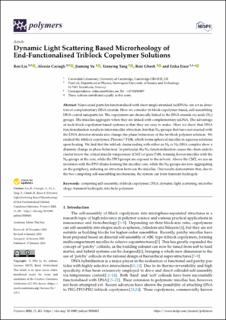| dc.contributor.author | Liu, Ren | |
| dc.contributor.author | Caciagli, Alessio | |
| dc.contributor.author | Yu, Jiaming | |
| dc.contributor.author | Tang, Xiaoying | |
| dc.contributor.author | Ghosh, Rini | |
| dc.contributor.author | Eiser, Erika | |
| dc.date.accessioned | 2024-01-19T08:55:16Z | |
| dc.date.available | 2024-01-19T08:55:16Z | |
| dc.date.created | 2023-11-30T11:46:36Z | |
| dc.date.issued | 2023 | |
| dc.identifier.citation | Polymers. 2023, 15 481-?. | en_US |
| dc.identifier.issn | 2073-4360 | |
| dc.identifier.uri | https://hdl.handle.net/11250/3112694 | |
| dc.description.abstract | Nano-sized particles functionalised with short single-stranded (ss)DNAs can act as detectors of complementary DNA strands. Here we consider tri-block-copolymer-based, self-assembling DNA-coated nanoparticles. The copolymers are chemically linked to the DNA strands via azide (N3) groups. The micelles aggregate when they are linked with complementary ssDNA. The advantage of such block-copolymer-based systems is that they are easy to make. Here we show that DNA functionalisation results in inter-micellar attraction, but that N3-groups that have not reacted with the DNA detector strands also change the phase behaviour of the tri-block polymer solution. We studied the triblock copolymer, Pluronic® F108, which forms spherical micelles in aqueous solutions upon heating. We find that the triblock chains ending with either an N3 or N3-DNA complex show a dramatic change in phase behaviour. In particular, the N3-functionalisation causes the chain ends to cluster below the critical micelle temperature (CMT) of pure F108, forming flower-micelles with the N3-groups at the core, while the PPO groups are exposed to the solvent. Above the CMT, we see an inversion with the PPO chains forming the micellar core, while the N3-groups are now aggregating on the periphery, inducing an attraction between the micelles. Our results demonstrate that, due to the two competing self-assembling mechanisms, the system can form transient hydrogels. | en_US |
| dc.description.abstract | Dynamic Light Scattering Based Microrheology of End-Functionalised Triblock Copolymer Solutions | en_US |
| dc.language.iso | eng | en_US |
| dc.publisher | MDPI | en_US |
| dc.rights | Navngivelse 4.0 Internasjonal | * |
| dc.rights.uri | http://creativecommons.org/licenses/by/4.0/deed.no | * |
| dc.subject | Soft Matter Physics | en_US |
| dc.subject | Soft Matter Physics | en_US |
| dc.title | Dynamic Light Scattering Based Microrheology of End-Functionalised Triblock Copolymer Solutions | en_US |
| dc.title.alternative | Dynamic Light Scattering Based Microrheology of End-Functionalised Triblock Copolymer Solutions | en_US |
| dc.type | Peer reviewed | en_US |
| dc.type | Journal article | en_US |
| dc.description.version | publishedVersion | en_US |
| dc.subject.nsi | VDP::Kondenserte fasers fysikk: 436 | en_US |
| dc.subject.nsi | VDP::Condensed matter physics: 436 | en_US |
| dc.source.pagenumber | 481-? | en_US |
| dc.source.volume | 15 | en_US |
| dc.source.journal | Polymers | en_US |
| dc.identifier.doi | 10.3390/polym15030481 | |
| dc.identifier.cristin | 2206280 | |
| dc.relation.project | Norges forskningsråd: 262644 | en_US |
| cristin.ispublished | true | |
| cristin.fulltext | original | |
| cristin.qualitycode | 1 | |

